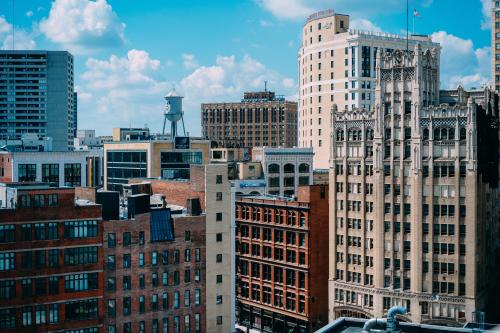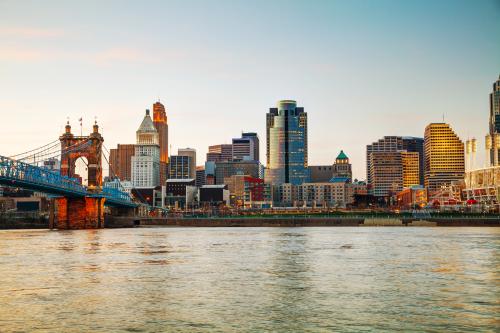The United States is about to enter its 10th year of economic expansion, dating back to the end of the Great Recession in June 2009. Job growth is robust, the unemployment rate is low, and median household income is at an all-time high.
Yet there remains a strong sense, punctuated by the results of the 2016 presidential election, that many parts of the country have been left behind in the rising tide.
Regional inequality is on the rise
The evidence backs this up. Almost four in five urban areas nationwide had household incomes in 2016 at least 5 percent lower than their levels in 1999. Many of the hardest-hit communities were small to mid-sized areas throughout the Midwest, Northeast, and Southeast still feeling the effects of long-run industrial decline.
These sorts of gaps don’t necessarily persist over time. As Paul Krugman recently observed, in the 1930s, per capita income in Mississippi was 70 percent lower than that in Massachusetts. By the late 1970s, that margin had shrunk to about 30 percent. Throughout the middle of the 20th century, industries flocked to the South for more affordable land and labor, and people moved there for more affordable housing and better weather (aided by the advent of air conditioning).
Older industrial cities can thus be the glue that binds together a more cohesive U.S. economy, where a larger share of our people and places have pathways to prosperity.
That process of what economists call “regional convergence” has stalled, however. Economist Elisa Giannone shows that the wage gap between richer and poorer U.S. metro areas shrank from 1940 to 1980, but grew thereafter, particularly for more educated workers. As Enrico Moretti illustrates in The New Geography of Jobs, our services-driven economy increasingly values the aggregation of highly skilled workers and innovative companies in large urban areas to drive growth. These dynamics have left the United States with a problem of growing regional inequality, a phenomenon many worry—with good reason—is tearing at the fabric of our society and democracy.
Responses: Promote mobility, or help left-behind communities
Recommendations for tackling these issues have largely come in two varieties. In the first, analysts argue that we should focus on improving the affordability of our large, successful cities, so that more people could afford to move there for plentiful jobs and opportunities for upward mobility. Moretti and his co-author conclude that metropolitan populations in New York and Silicon Valley would need to double to achieve significant increases in national economic growth. It’s hard to argue against that approach, when the median single-family home sales price in San Francisco today hovers around $1.5 million.
The second variety of recommendation focuses, conversely, on assisting the hardest-hit local economies. Many of these are the centers of what Case and Deaton refer to as “deaths of despair” for middle-aged non-Hispanic whites from suicide and drug/alcohol-related causes. Austin, Summers, and Glaeser conclude that government investment in these types of depressed economies may be appropriate because it would generate a significant positive impact on local employment rates and, by extension, other important markers of local well-being.
A third way: Invest in older industrial cities
There’s an overlooked middle ground, however, between focusing on either our most or least economically successful communities.
That’s the assertion of our new report, Renewing America’s economic promise through older industrial cities. As the title suggests, my co-author Cecile Murray and I see a collection of urban areas throughout the nation’s industrial heartland as promising anchors for mitigating rising regional inequality. We identify 70 older industrial cities—places like Akron, Ohio and Albany, Ga.; New Bedford, Mass. and Newark, N.J.; St. Louis, Mo. and St. Paul, Minn.—that were once the engines of America’s unparalleled manufacturing prowess, but have since struggled to grow jobs in new industries.
Yet our research finds that these places are defined more accurately by their assets than their deficits. Most are centers of significant technological know-how, embedded in their research universities, world-class health care institutions, and globally-connected advanced industry companies. Many are benefiting from new residential and commercial investment in the urban core, and in some cases, the “reverse migration” of workers from expensive coastal markets. As a result, these cities are home to a younger, more diverse workforce that can facilitate local adaptation in an increasingly pluralistic society. These cities today remain home to fully one-eighth of U.S. population and GDP.
Of course, older industrial cities still confront significant challenges, particularly around ensuring success for their longstanding communities of color. But many local and state leaders increasingly recognize that unlocking the potential of these populations and their wider urban areas—through smart investments in job creation, job preparation, and job access—is critical to achieving more inclusive economic growth.
The Bay Area should undoubtedly build more housing. And we ought to provide much stronger economic adjustment support for areas like Eastern Kentucky. At the same time, we shouldn’t expect most coal country residents to pick up and move to Haight-Ashbury. They would benefit much more from having a stronger Louisville, Cincinnati, and Roanoke nearby. Older industrial cities can thus be the glue that binds together a more cohesive U.S. economy, where a larger share of our people and places have pathways to prosperity.







Commentary
Older industrial cities are key to addressing rising regional inequality
Monday, April 23, 2018